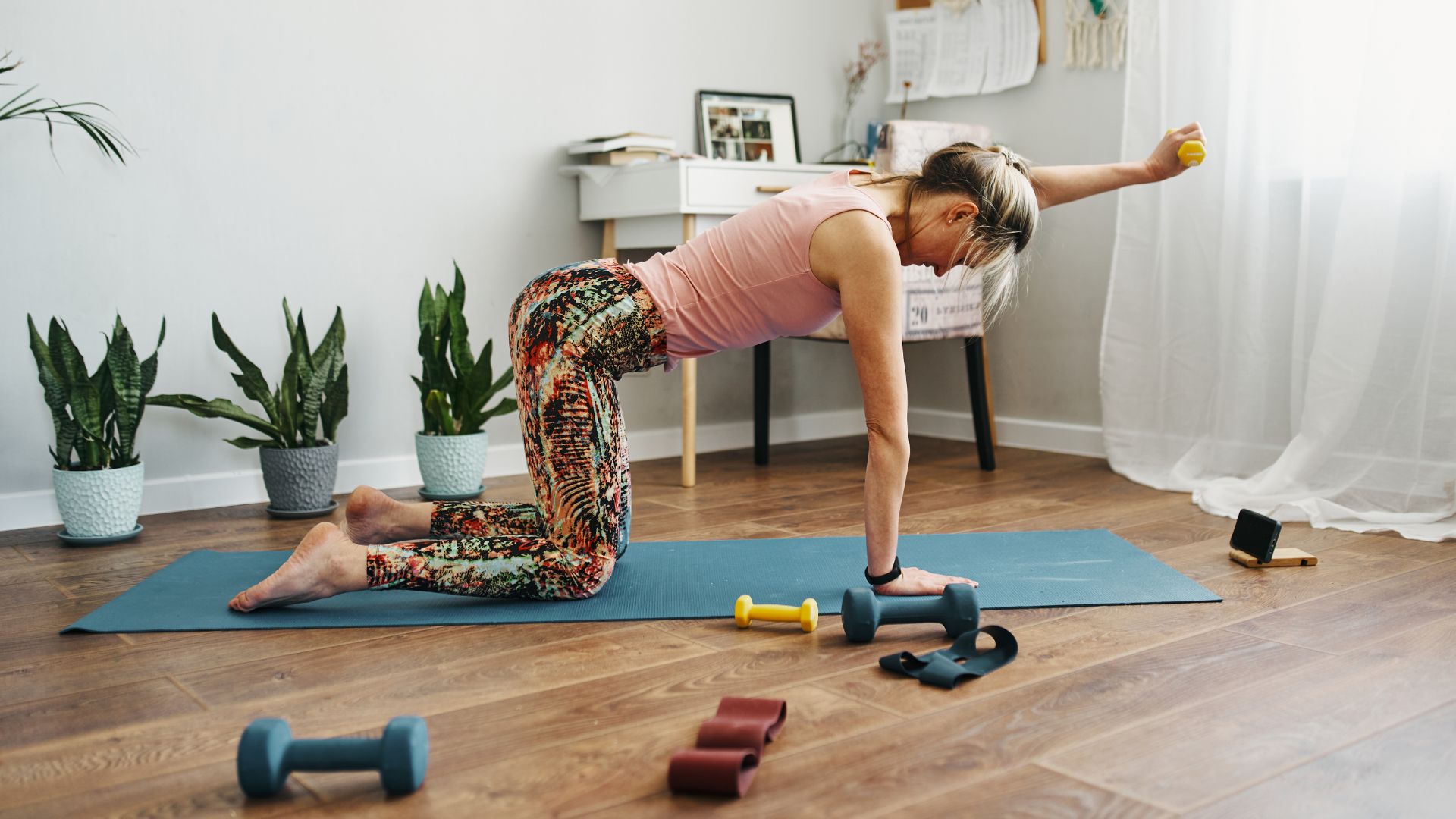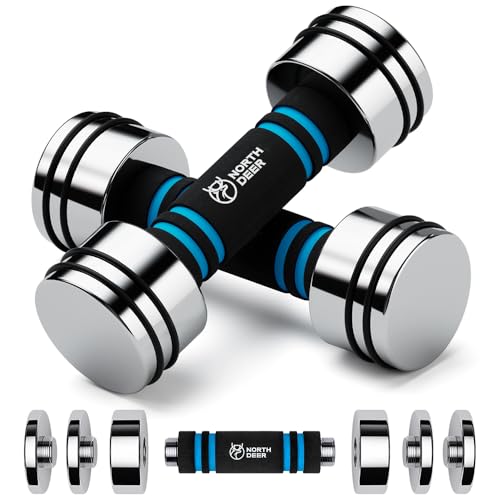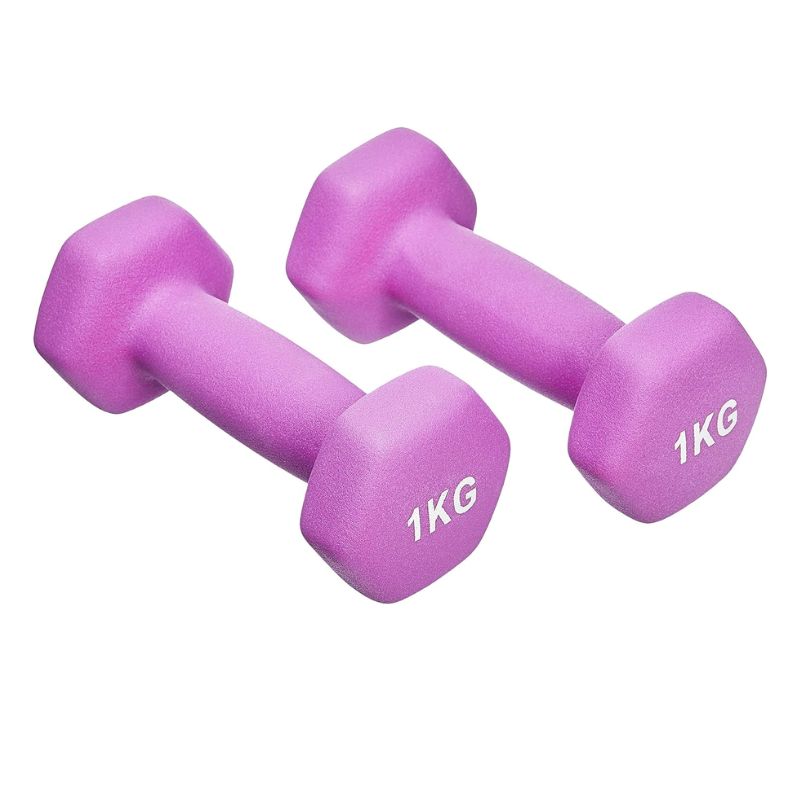Skip the gym - you can do Pilates with weights at home with these 5 easy moves
You can get stronger using your lightest dumbbell by doing Pilates with weights. Here, instructors reveal the exercises they recommend


If you dread the sight of a weights rack but are looking to get stronger and maintain muscle mass as you age, Pilates with weights could be for you. The weights may be lighter than in traditional strength training but there are still plenty of benefits.
Maintaining muscle mass is essential as we age, especially during perimenopause when we begin to lose some of oestrogen's protective benefits. Strength training, whether that's with light dumbells in weighted Pilates or the gym, can make a hugely positive difference to daily life in the years to come. It's also a great way to get stronger, gain more muscle definition, and reap the mental health benefits of exercise.
A session of weighted Pilates is done with light weights, a thick yoga mat, and traditional movements to strengthen some of the body's most important muscles. It's the perfect way to "add on a little bit of extra spice and intensity" to your regular full-body Pilates workout, says Anna Mounsey-Jennings, a certified Pilates instructor and the founder of Avalon Pilates. "It adds more resistance to the exercise and thus more challenge," she says. With the help of fellow Pilates instructor Rebecca Douden, founder of the Pilates Prescription, we've created a Pilates with weights workout for beginners...
Pilates with weights workout
1. Standing squats with arm reaches
Taking a light dumbbell in each hand, here's how to do a standing squat with arm reaches, as demonstrated by Rebecca above:
- Get into a comfortable squat position with your feet shoulder-width apart and feet slightly turned down.
- Take a deep breath, exhale, and squat down while raising the weights above your head in one fluid motion.
- As you come out of the squat, bring your arms down.
- Repeat the movement.
2. Bird dog
Keeping that same dumbbell in one hand, come down to your yoga mat. Anna demonstrates how to do a bird-dog with weights above:
- Come down onto all fours with your knees under your hips and hands under your shoulders.
- Take a deep breath in and out, and reach the arm with the weight forward and the opposite leg back behind you, holding it for a moment.
- Ensure your pelvis is stable and your ribcage is 'drawing up', i.e. pulling your belly inward to activate your core.
- Bring your elbow to your knee with your exhale.
- Repeat the exercise - inhale, extend the arm and leg again, then switch to the other side.
- "You can do 10 reps on each side and then add in some pulses or holds to intensify," says Anna.
3. Donkey kicks
Maintain your position on the yoga mat and keep your handheld weight close by - donkey kicks, also called fire hydrants, are the next exercise as demonstrated by Rebecca:
- Stay kneeling on all fours, making sure your hips are directly over your knees and your shoulders sit on top of your elbows.
- Place the weight in the crook of your knee, where it's held in place.
- Inhale, exhale. Lift one leg, pushing your foot directly up towards the ceiling.
- "Make sure to keep your spine long and your core engaged," says Rebecca. "As you lift the leg, especially the back tends to arch and we want to avoid this."
- Bring your knee back down to the floor slowly.
- Repeat the exercise 10 times, then switch legs.
4. Side planks
Knowing how to do a side plank is essential in a bodyweight workout, whether that's Pilates or barre, the ballet-inspired workout. Anna demonstrates how to do one:
Sign up to our free daily email for the latest royal and entertainment news, interesting opinion, expert advice on styling and beauty trends, and no-nonsense guides to the health and wellness questions you want answered.
- Moving onto your side and prop your upper body onto your elbow.
- Put one foot in front of the other on the mat, making sure your back is straight and hips are aligned.
- Lift your hips up into a side plank and hold.
- From here, rotate your top arm (holding the weight) and spiral your arm and chest down.
- If you find this easy, Anna suggests holding the position with your arm above your head and pulsing.
- Try this 10 times and then repeat on the other side.
5. Arm flies in 4-point kneeling
Remaining on the mat, arm flies are the last of the upper-body exercises. "In four-point kneeling, focus on your form first and don't let the back arch drop," says Rebecca, who demonstrates the exercise above. "I use weights that challenge me but also allow me full range of movement through the joint."
- Keeping your hips above your knees and shoulders stacked over your elbows, take a weight in one hand.
- With your core engaged, shoulders back and down, breathe in and out.
- Reach out to the side with the weight, aiming to lift the weight up until it falls in line with your arm, directly parallel to your shoulder.
- Pause for a moment, before bringing the weight back to the starting position.
- Try this 10 times then switch sides.

A pair of adjustable dumbbells are your best friend if you're looking to develop a Pilates habit. This set from Amazon starts at 1kg and goes up to 2.5kg, leaving you room to improve while starting manageable, and you simply take the small plates on and off the handle to adjust.

With options from 1kg to 5kg, Amazon Basics' neoprene dumbbells are a good go-to if you want to try Pilates with weights on a budget. The pink is a fun pop of colour, the silicone covering makes them easy to grip, and the hexagonal shape means they won't roll away mid-arm raise.

Looking for weights that wouldn't look out of place in an art gallery? Onyx's range of dumbbells look like small sculptures, so you can keep them out in the open. They are made of silicone-covered iron, available in 1kg or 2kg, and come in multiple colours to suit your space. Whether you're doing STOTT Pilates or a quick 10-minute workout, they can help you out.
Is Pilates with weights effective?
Absolutely, doing Pilates with weights can be very effective for building full-body strength, including core strength without doing a specific Pilates abs workout. It can also help build muscle, which leads to a 'toned' appearance and helps with muscle maintenance. Compared to a regular yoga mat workout, it's significantly more challenging.
There are also benefits exclusive to Pilates with weights that those doing a gym dumbbell workout won't get. "Your traditional weight lifter will not be getting the flow part, so we need to use lighter weights to allow the flow and to allow a range of movement through the joints," says Rebecca. "Pilates with resistance like weights and ankle weights may not be the same but can be very challenging."
However, for major improvements in strength, balance, stability, and muscle mass, the experts recommend including some classic strength training for women in your routine. It could be a basic resistance band leg workout or doing a program of strength training at home for beginners - either way, there are benefits you won't necessarily get from Pilates with weights.
"Weight training uses progressive overload to increase muscle strength. So, if you're looking to [significantly build muscle] then weight training will be more beneficial for you," says Anna. "I think you should be doing both as you get different benefits from each."
How heavy should weights be for Pilates?
If you're totally new to strength workouts, doing Pilates for beginners, or haven't done Pilates with weights before, it's recommended you begin with a selection of light weights - between 0.5kg and 1.5kg. Once you've developed a habit and a routine, you can work up to heavier weights.
While we tend to use ankle weights for walking, they can also be very useful as dumbbell replacements in Pilates workouts. Wrapping around the ankle or the wrist, depending on which part of the body you're focusing on, they can be easier to manoeuvre than weights.
Although, you still shouldn't feel like your weighted Pilates workout is the same as lifting weights in the gym. The 'flow' aspect of the workout is very important.

Grace Walsh is woman&home's Health Channel Editor, working across the areas of fitness, nutrition, sleep, mental health, relationships, and sex. She is also a qualified fitness instructor. In 2025, she will be taking on her third marathon in Brighton, completing her first ultra marathon, and qualifying as a certified personal trainer and nutrition coach.
A digital journalist with over seven years experience as a writer and editor for UK publications, Grace has covered (almost) everything in the world of health and wellbeing with bylines in Cosmopolitan, Red, The i Paper, GoodtoKnow, and more.